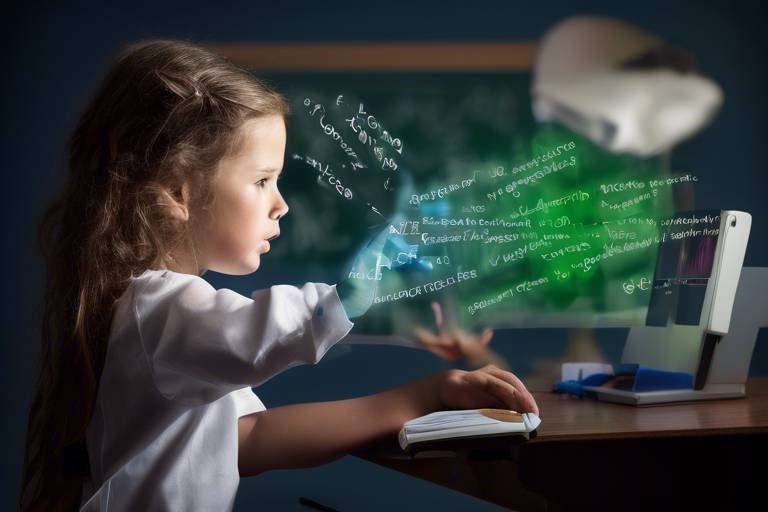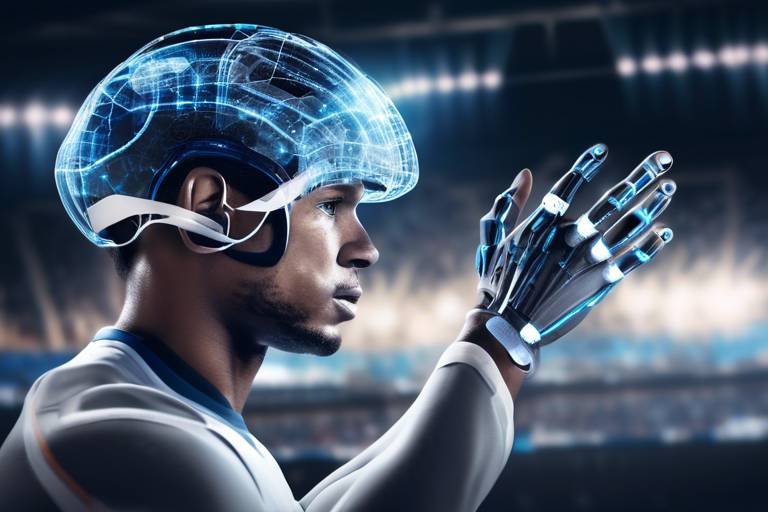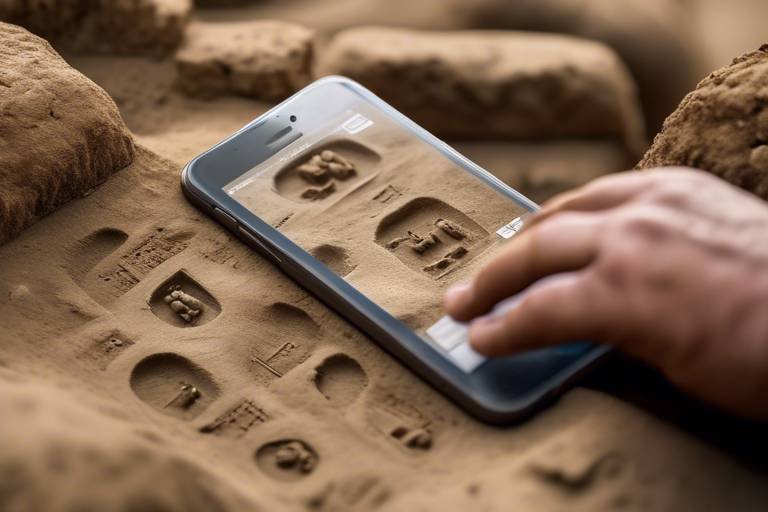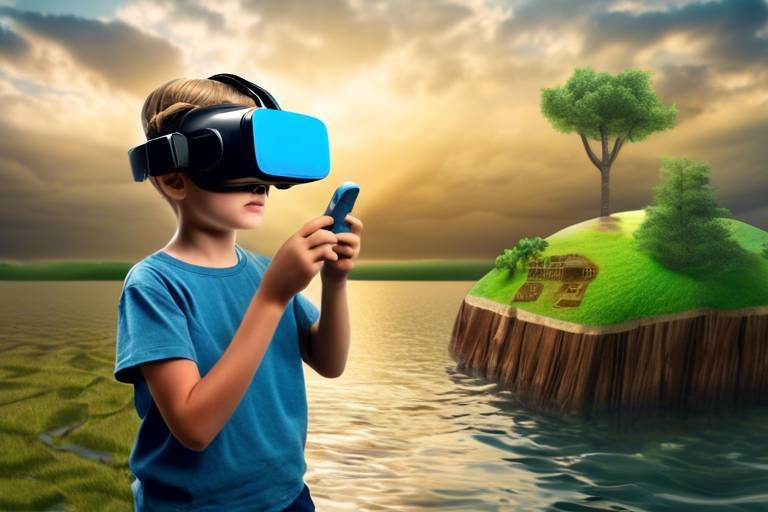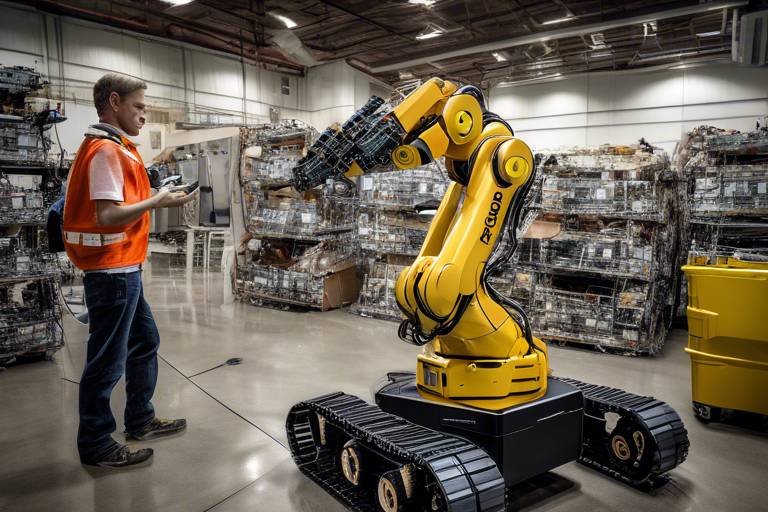How Technology is Transforming Educational Science
In today’s fast-paced world, the integration of technology into educational science is not just a trend; it’s a revolution! The way we teach and learn is undergoing a seismic shift, driven by innovative digital tools and resources. Imagine walking into a classroom where traditional textbooks are replaced by interactive screens, and lectures are transformed into engaging virtual experiences. This is the new normal, where technology plays a pivotal role in enhancing educational methodologies.
The transformation is not merely about flashy gadgets; it's about creating a more inclusive and effective learning environment. With technology, education is becoming more accessible to diverse audiences, breaking down barriers that once existed. Whether it’s a student in a remote village or a professional seeking to upskill, technology offers tailored solutions that cater to individual needs. In this article, we will delve into the various facets of how technology is reshaping educational science, from e-learning to artificial intelligence.
E-learning has revolutionized education by providing flexible and accessible learning opportunities. Gone are the days when students were confined to a classroom for hours on end. Now, they can learn at their own pace, from anywhere in the world. This shift has been accelerated by the global pandemic, which forced educational institutions to embrace online platforms. The benefits of e-learning are numerous:
- Flexibility: Students can choose when and where to study, allowing them to balance their education with other responsibilities.
- Accessibility: Online courses can reach learners in remote areas, providing opportunities that were previously unavailable.
- Diverse Learning Styles: E-learning platforms often incorporate various multimedia tools, catering to different learning preferences.
As e-learning continues to grow, it’s essential to recognize its ability to cater to diverse learning styles and needs. With interactive modules, video tutorials, and discussion forums, students are no longer mere spectators; they are active participants in their learning journey.
Interactive learning technologies, such as virtual classrooms and gamification, engage students more effectively than traditional methods. Imagine a classroom where students are not just listening to a lecture but are actively participating in a game that reinforces their understanding of complex concepts. This kind of engagement is crucial for retention and comprehension.
One of the most exciting advancements in educational technology is Virtual Reality (VR). VR offers immersive experiences that deepen understanding, allowing students to explore subjects like science and history in a way that textbooks simply cannot provide. Picture a history lesson where students can virtually walk through ancient Rome or a science class where they can conduct experiments in a simulated lab environment. This level of engagement not only captivates students but also fosters a deeper connection to the material.
Real-world examples illustrate the successful integration of VR in classrooms. For instance, a school district in California implemented VR technology in their science curriculum, allowing students to conduct virtual dissections. The results were astounding: students reported higher engagement levels and improved understanding of complex biological processes. Such case studies showcase the potential of VR to transform traditional teaching methods and enhance student engagement.
Despite its benefits, adopting VR in education faces challenges, including cost and accessibility. Many schools struggle with the financial burden of acquiring VR equipment and training staff. However, potential solutions exist, such as partnerships with tech companies and grants aimed at educational innovation. By addressing these hurdles, we can pave the way for broader implementation of VR in classrooms.
Artificial intelligence (AI) is reshaping personalized learning experiences. Imagine a classroom where each student receives a tailored curriculum based on their strengths and weaknesses. AI makes this possible by analyzing data and adapting educational content to meet individual student needs and preferences. This level of customization not only enhances learning outcomes but also boosts student confidence.
Data analytics in education enables institutions to make informed decisions. By collecting and analyzing data on student performance, educators can identify trends and adjust their teaching strategies accordingly. This data-driven approach leads to improved teaching strategies and better student outcomes.
Analyzing student performance data helps educators identify strengths and weaknesses. Various assessment tools, such as online quizzes and interactive assignments, provide valuable insights into student learning. This section discusses how these tools impact educational strategies, allowing for a more responsive and effective teaching approach.
Predictive analytics can forecast student success and retention rates. By leveraging historical data, institutions can identify at-risk students and implement targeted support services. This proactive approach not only enhances student success but also fosters a culture of support within educational institutions.
- How is technology improving accessibility in education?
Technology provides flexible learning options and resources that can reach students in remote or underserved areas. - What role does VR play in modern education?
VR immerses students in interactive environments, enhancing engagement and understanding of complex subjects. - How can AI personalize learning?
AI analyzes student data to tailor educational content, ensuring it meets individual learning needs.

The Rise of E-Learning
E-learning has truly revolutionized the landscape of education, making learning more flexible and accessible than ever before. Gone are the days when students were confined to traditional classrooms with rigid schedules and limited resources. Now, with just a click, anyone can access a wealth of knowledge from the comfort of their home or on the go. This transformation has been fueled by advancements in technology, which have opened up a world of opportunities for learners of all ages and backgrounds.
One of the most significant benefits of e-learning is its ability to cater to diverse learning styles. Whether you’re a visual learner who thrives on videos and graphics, an auditory learner who benefits from podcasts and discussions, or a kinesthetic learner who prefers hands-on activities, e-learning platforms offer a variety of resources to meet your needs. This personalized approach not only enhances understanding but also boosts motivation and engagement.
Additionally, e-learning provides a level of flexibility that traditional education simply cannot match. Students can learn at their own pace, revisiting materials as needed, which is particularly beneficial for complex subjects. Imagine being able to pause a lecture, rewind, and replay sections to ensure complete comprehension. This kind of tailored learning experience is invaluable and promotes a deeper understanding of the material.
Moreover, e-learning has become a vital tool in breaking down geographical barriers. Students from remote areas or those with mobility challenges can now access high-quality education without the need to travel. This democratization of learning is a game-changer, allowing individuals to pursue their educational goals regardless of their circumstances.
However, the rise of e-learning is not without its challenges. Issues such as digital divide, where some students lack access to necessary technology or reliable internet, can hinder the effectiveness of online education. Educational institutions must address these hurdles to ensure that e-learning is truly inclusive and equitable.
In summary, the rise of e-learning marks a significant shift in how education is delivered and consumed. It provides flexible, personalized, and accessible learning experiences that cater to a variety of needs. As we continue to embrace this digital transformation, it’s essential to address the challenges that come with it, ensuring that all learners can benefit from the opportunities that e-learning offers.

Interactive Learning Technologies
In the ever-evolving landscape of education, have emerged as a game-changer, transforming the way students engage with content. These technologies, which include everything from virtual classrooms to gamification techniques, are designed to foster a more engaging and participatory learning environment. Imagine a classroom where students are not just passive recipients of information, but active participants in their learning journey. This shift is not just a trend; it's a revolution that caters to the diverse learning styles and needs of today’s students.
One of the most exciting aspects of interactive learning technologies is their ability to make education more accessible and flexible. With tools like online discussion forums, interactive quizzes, and collaborative projects, students can learn at their own pace and in their own style. For instance, a student who struggles with traditional lecture formats can benefit from interactive videos or simulations that allow them to grasp complex concepts through hands-on experience. This approach not only enhances understanding but also boosts retention rates, making learning a more enjoyable and effective process.
Moreover, the integration of gamification into educational settings has proven to be a powerful motivator for students. By incorporating elements of game design—such as points, levels, and rewards—educators can create an environment that encourages competition and collaboration. For example, a classroom that uses a points system for completing assignments or participating in discussions can spark a friendly rivalry that pushes students to engage more deeply with the material. The thrill of earning badges or unlocking new levels can turn mundane tasks into exciting challenges, making learning feel less like a chore and more like an adventure.
Let’s take a closer look at some of the key technologies that are reshaping interactive learning:
| Technology | Description | Benefits |
|---|---|---|
| Virtual Classrooms | Online platforms that simulate a traditional classroom environment. | Flexibility, accessibility, and real-time interaction. |
| Gamification | Incorporating game elements into learning activities. | Increased motivation and engagement among students. |
| Interactive Simulations | Real-world scenarios that allow students to apply their knowledge. | Hands-on learning and deeper understanding of complex concepts. |
As we delve deeper into the world of interactive learning technologies, it’s essential to recognize the role of collaborative tools. Platforms like Google Classroom and Microsoft Teams enable students to work together, share resources, and provide feedback in real-time. This collaborative spirit not only enhances learning but also prepares students for the teamwork that is vital in today’s workforce. When students collaborate on projects, they learn to communicate effectively, resolve conflicts, and leverage each other's strengths—skills that are invaluable in any career.
In conclusion, interactive learning technologies are not just enhancing education; they are redefining it. By creating dynamic, engaging, and collaborative learning environments, these tools empower students to take control of their education. As we continue to embrace these innovations, the future of learning looks brighter than ever. Are you ready to see how these technologies can transform your educational experience?
Q: What are interactive learning technologies?
A: Interactive learning technologies refer to digital tools and platforms that promote active participation and engagement in the learning process, such as virtual classrooms, gamification, and collaborative tools.
Q: How do these technologies benefit students?
A: They provide flexibility, cater to diverse learning styles, enhance motivation, and foster collaboration among students, leading to improved learning outcomes.
Q: Can interactive learning technologies be used in traditional classrooms?
A: Absolutely! Many interactive technologies can be integrated into traditional classroom settings to enhance the learning experience and engage students more effectively.

Virtual Reality in Education
Imagine stepping into a world where the boundaries of traditional learning dissolve, and students can explore the depths of the ocean or walk through ancient civilizations without ever leaving their classroom. Virtual Reality (VR) is not just a futuristic concept; it's a powerful educational tool that is transforming the way we teach and learn. By providing immersive experiences, VR allows students to engage with complex subjects in a way that textbooks simply cannot match. Whether it's conducting virtual chemistry experiments or experiencing historical events first-hand, the potential for enhanced understanding is limitless.
One of the most exciting aspects of VR in education is its ability to cater to different learning styles. For visual learners, the vibrant, 3D environments can make abstract concepts tangible. Kinesthetic learners, who thrive on hands-on experiences, can manipulate virtual objects, making learning both fun and effective. This ability to personalize education is crucial, as it acknowledges that every student has unique preferences and needs.
Moreover, VR can foster collaboration among students. Imagine a classroom where learners from different parts of the world come together in a virtual environment to solve problems or work on projects. This not only enhances social skills but also prepares students for a globalized workforce where teamwork and communication are key. As educators, we have a responsibility to equip our students with the tools they need to thrive in an increasingly interconnected world.
However, the implementation of VR in education is not without its challenges. The cost of VR equipment can be prohibitive for many schools, particularly those in underfunded districts. Additionally, there are concerns about accessibility; not all students may have the opportunity to experience VR due to technological limitations. To address these issues, schools and educational institutions must explore partnerships with technology companies and seek grants that can help subsidize costs.
As we look to the future, the integration of VR in education is poised to expand further. With ongoing advancements in technology, we can expect more affordable and accessible VR solutions that can be seamlessly integrated into existing curricula. The key is to remain open to innovation while ensuring that we prioritize the educational needs of our students. The journey into the world of virtual reality is just beginning, and its potential to revolutionize education is both exciting and inspiring.
- What is Virtual Reality in Education?
Virtual Reality in education refers to the use of immersive, computer-generated environments to enhance learning experiences. - How can VR benefit students?
VR can provide hands-on experiences, cater to various learning styles, and foster collaboration among students. - What are the challenges of implementing VR in schools?
Challenges include high costs, accessibility issues, and the need for adequate training for educators. - Is VR the future of education?
While VR has great potential, it should complement traditional teaching methods rather than replace them.

Case Studies of VR Implementation
As we dive into the world of Virtual Reality (VR) in education, it's essential to look at real-life examples that illustrate its transformative potential. One of the most notable case studies comes from Stanford University, where researchers developed a VR program aimed at teaching empathy through immersive experiences. In this program, students can step into the shoes of individuals from different backgrounds, helping them understand diverse perspectives. This innovative approach not only enhances emotional intelligence but also fosters a more inclusive classroom environment.
Another fascinating case study is from the University of Maryland, where VR is utilized in teaching anatomy to medical students. Traditional methods often involve textbooks and cadaver dissections, which can be limited in scope. However, with VR, students can explore 3D models of the human body, allowing them to visualize complex structures from multiple angles. This immersive learning experience has shown to improve retention rates significantly, with students reporting higher confidence levels in their understanding of anatomical relationships.
In high schools, VR is making waves as well. A notable example is the Virtual Reality Science Lab implemented in a school district in California. Students can conduct experiments in a virtual lab environment, where they can manipulate variables and observe outcomes without the constraints of a physical lab. This not only saves costs on materials but also allows students to engage in experiments that may be too dangerous or costly in real life. Feedback from both students and teachers has been overwhelmingly positive, with many noting increased enthusiasm for science subjects.
Moreover, organizations like ClassVR are leading the charge in providing schools with VR headsets and educational content tailored to various subjects. Their platform allows teachers to create customized lessons that incorporate VR experiences, making learning more interactive and engaging. Schools that have adopted ClassVR have reported a marked improvement in student participation and understanding of complex topics.
While these case studies demonstrate the efficacy of VR in educational settings, it's important to acknowledge the challenges that come with implementation. Factors such as cost, training, and accessibility can hinder widespread adoption. However, the success stories from these institutions provide a roadmap for overcoming these hurdles. By investing in the right technologies and training educators to use them effectively, schools can harness the full potential of VR to create dynamic and engaging learning environments.
- What is Virtual Reality in education?
Virtual Reality (VR) in education refers to the use of immersive technology to create interactive learning experiences that enhance understanding and engagement.
- How can VR improve student learning?
VR can improve student learning by providing hands-on experiences, enhancing retention through immersive simulations, and fostering empathy through perspective-taking.
- Are there any challenges to implementing VR in classrooms?
Yes, challenges include high costs, the need for teacher training, and ensuring accessibility for all students.
- Can VR be used for all subjects?
VR can be applied across various subjects, including science, history, and even language learning, making it a versatile tool for educators.

Challenges of VR Adoption
While the potential of Virtual Reality (VR) in education is incredibly exciting, the journey to widespread adoption is fraught with challenges. One of the most significant hurdles is the cost associated with implementing VR technology. Schools and educational institutions often operate on tight budgets, and the expense of purchasing VR headsets, software, and the necessary hardware can be prohibitive. Additionally, maintaining and upgrading this technology requires ongoing investment, which may not be feasible for all institutions.
Another challenge is accessibility. Not all students have equal access to the necessary technology at home, which can create disparities in learning opportunities. Imagine a classroom where some students are immersed in a VR experience while others are left out due to lack of resources. This not only hampers the learning experience but can also lead to feelings of exclusion among those who cannot participate fully.
Moreover, there is a steep learning curve associated with integrating VR into existing curricula. Teachers need proper training to effectively use these tools and create engaging content. Without adequate professional development, educators may feel overwhelmed or unsure about how to incorporate VR into their teaching strategies. This can result in underutilization of the technology, negating its potential benefits.
Additionally, we must consider the health and safety concerns related to prolonged VR use. Issues such as motion sickness, eye strain, and physical discomfort can arise, particularly for younger students. Ensuring that VR experiences are designed with user comfort in mind is crucial to fostering a positive learning environment.
To tackle these challenges, educational institutions can consider the following strategies:
- Collaborating with technology companies for funding or discounts on hardware and software.
- Implementing VR technology in phases to spread out costs and allow for gradual integration.
- Offering comprehensive training programs for teachers to build confidence in using VR tools.
- Designing VR experiences that include breaks and are mindful of potential health issues.
In conclusion, while the adoption of VR in education presents challenges, with thoughtful planning and collaboration, these obstacles can be overcome. The future of learning could very well be transformed by the immersive experiences that VR offers, but it requires a concerted effort from educators, administrators, and technology providers to make it a reality.
Q: What are the main challenges of adopting VR in education?
A: The main challenges include cost, accessibility, the learning curve for educators, and health and safety concerns related to prolonged use of VR technology.
Q: How can schools address the cost of VR technology?
A: Schools can collaborate with technology companies for funding or discounts, implement VR technology in phases, and seek grants specifically for educational technology.
Q: What training is necessary for teachers to effectively use VR?
A: Comprehensive training programs that cover both the technical aspects of using VR tools and pedagogical strategies for integrating VR into lessons are essential for teachers.
Q: Are there health concerns associated with VR use in education?
A: Yes, prolonged use of VR can lead to motion sickness, eye strain, and physical discomfort, which is why it's important to design experiences that account for user comfort.

Artificial Intelligence in Learning
Artificial Intelligence (AI) is not just a buzzword; it's a game-changer in the educational landscape. Imagine a classroom where every student receives personalized attention tailored to their unique learning style. Sounds like a dream, right? Well, with AI, this dream is becoming a reality! AI technologies are revolutionizing the way we approach education by providing adaptive learning experiences that cater to individual needs.
One of the most significant advantages of AI in education is its ability to analyze vast amounts of data quickly. This capability allows educators to understand how students learn and where they struggle. For instance, AI systems can track a student's progress in real-time, identifying patterns and suggesting resources that can help them improve. It's like having a personal tutor available 24/7, guiding students through their educational journey.
Moreover, AI can enhance the learning experience by offering interactive content. For example, platforms that utilize AI can adjust the difficulty of tasks based on a student's performance, ensuring that they are always challenged but never overwhelmed. This adaptive learning approach not only keeps students engaged but also boosts their confidence as they master new concepts at their own pace.
So, how exactly does AI tailor educational content? Here are a few ways:
- Personalized Learning Paths: AI algorithms assess a student's strengths, weaknesses, and preferences to create customized learning paths.
- Intelligent Tutoring Systems: These systems provide immediate feedback and guidance, helping students grasp complex subjects more effectively.
- Content Recommendation: AI can suggest additional resources, such as articles, videos, or exercises, that align with a student's interests and learning goals.
The integration of AI in education also opens up new avenues for teachers. With AI handling routine tasks, such as grading and administrative work, educators can focus more on what they do best—teaching! This shift not only enhances the teaching experience but also allows for more meaningful interactions between teachers and students.
However, the journey of incorporating AI into learning is not without its challenges. Concerns about data privacy, the need for teacher training, and the potential for technology to replace human interaction are significant hurdles that need to be addressed. As we navigate these challenges, it's essential to strike a balance between leveraging technology and maintaining the human touch that is so vital in education.
In conclusion, AI is reshaping the educational landscape, making learning more personalized, efficient, and engaging. As we look to the future, the potential for AI in education is enormous, and with continued innovation and thoughtful implementation, we can create learning environments that truly cater to every student's needs.
Here are some common questions regarding the role of Artificial Intelligence in education:
- How does AI improve student learning? AI provides personalized learning experiences, adapts content to student needs, and offers real-time feedback, enhancing overall engagement and understanding.
- What are the challenges of implementing AI in education? Key challenges include data privacy concerns, the need for adequate teacher training, and ensuring that technology complements rather than replaces human interaction.
- Can AI replace teachers? While AI can automate certain tasks and provide support, it cannot replace the essential human elements of teaching, such as empathy and personal connection.

Data-Driven Decision Making
In today's rapidly evolving educational landscape, has emerged as a cornerstone for enhancing teaching and learning experiences. With the advent of advanced analytics tools, educational institutions are now equipped to sift through vast amounts of data to extract actionable insights. This shift towards a more analytical approach not only empowers educators but also significantly improves student outcomes. But what exactly does this mean for schools, teachers, and students alike?
At its core, data-driven decision making involves collecting, analyzing, and interpreting data to inform educational strategies. Schools gather data from various sources, including standardized test scores, attendance records, and even social-emotional learning assessments. By leveraging this information, educators can pinpoint areas of strength and weakness, tailoring their teaching methods to better meet the needs of their students. Imagine a teacher who can identify that a particular group of students struggles with math concepts; with this knowledge, they can implement targeted interventions that are much more effective than a one-size-fits-all approach.
Furthermore, the integration of data analytics into educational practices allows for a more personalized learning experience. For instance, adaptive learning platforms utilize algorithms to adjust content based on a student's performance in real-time. This means that students can learn at their own pace, receiving the support they need when they need it. The beauty of this approach is that it not only fosters a deeper understanding of the material but also boosts student confidence and motivation.
To illustrate the impact of data-driven decision making, consider the following table that outlines key benefits:
| Benefit | Description |
|---|---|
| Improved Student Outcomes | Data helps identify learning gaps, allowing for timely interventions. |
| Informed Instructional Strategies | Teachers can adapt their methods based on student performance data. |
| Enhanced Resource Allocation | Schools can allocate funding and resources more effectively based on data insights. |
| Increased Accountability | Data provides a transparent way to measure educational effectiveness. |
However, it's essential to recognize that with great power comes great responsibility. The use of data in education raises important questions about privacy and ethical considerations. Schools must ensure that data is handled securely and that student privacy is prioritized. Additionally, educators need to be trained in data literacy to interpret the information accurately and make informed decisions. After all, data is only as good as the insights drawn from it.
In conclusion, the embrace of data-driven decision making in educational settings is not just a trend; it's a fundamental shift that is reshaping how we think about teaching and learning. By harnessing the power of data, educators can create more effective, personalized, and engaging learning environments that cater to the diverse needs of their students. As we move forward, the challenge lies in balancing the use of data with ethical practices to ensure that all students benefit from this innovative approach.
- What is data-driven decision making in education?
Data-driven decision making involves using collected data to inform and improve educational strategies and outcomes. - How can data improve student learning?
Data can identify learning gaps, allowing educators to tailor instruction to meet individual student needs. - What are the ethical considerations of using data in education?
Schools must prioritize student privacy and ensure data is handled securely while providing training for educators in data literacy.

Assessing Student Performance
Assessing student performance is a crucial aspect of the educational process, acting as a compass that guides teachers in understanding how well their students are grasping the material. With the advent of technology, the methods of assessment have evolved significantly, moving beyond traditional testing methods to incorporate innovative tools that provide deeper insights into student learning. This shift not only enhances the accuracy of assessments but also aligns with the diverse learning styles and needs of students.
One of the most exciting developments in this area is the use of data analytics. By collecting and analyzing data from various sources, educators can gain a comprehensive view of student performance. This includes tracking grades, attendance, participation, and even engagement levels during lessons. For instance, learning management systems (LMS) can provide real-time analytics that highlight trends and patterns in student performance, allowing teachers to identify which students are excelling and which may need additional support.
Moreover, the integration of formative assessments—ongoing assessments that inform instruction—has become increasingly popular. These assessments can take many forms, such as quizzes, peer reviews, or even interactive polls during class. They allow educators to gauge student understanding continuously and adjust their teaching strategies accordingly. This dynamic feedback loop is essential for fostering a growth mindset among students, encouraging them to view assessments as opportunities for improvement rather than mere evaluations of their abilities.
However, the challenge lies in ensuring that assessments are both fair and inclusive. Educators must consider the diverse backgrounds and learning preferences of their students when designing assessments. For example, some students may excel in traditional testing environments, while others may perform better through project-based assessments or oral presentations. To address this, many institutions are adopting a more holistic approach to assessment, which includes a variety of methods to cater to different learning styles. This approach not only promotes equity but also allows students to showcase their strengths in different areas.
To illustrate the effectiveness of various assessment methods, consider the following table that compares traditional assessments with modern, technology-driven assessments:
| Assessment Type | Traditional Assessments | Technology-Driven Assessments |
|---|---|---|
| Format | Standardized tests, essays | Interactive quizzes, simulations |
| Feedback Speed | Delayed feedback | Real-time feedback |
| Engagement | Passive | Active participation |
| Inclusivity | One-size-fits-all | Diverse methods for diverse learners |
In conclusion, assessing student performance in the digital age is not merely about assigning grades; it’s about creating a rich, engaging learning environment where every student can thrive. By leveraging technology and data analytics, educators can tailor their approaches to meet individual needs, ultimately leading to improved educational outcomes. As we continue to embrace these innovative assessment strategies, we pave the way for a more inclusive, effective, and engaging educational experience for all students.
- What are formative assessments, and why are they important? Formative assessments are ongoing evaluations that help teachers understand student learning progress, allowing for timely adjustments to instruction.
- How can technology improve student assessments? Technology can provide real-time feedback, track performance data, and offer diverse assessment formats that cater to different learning styles.
- What challenges do educators face in assessing student performance? Challenges include ensuring assessments are fair, inclusive, and accurately reflect student understanding across diverse backgrounds.

Predictive Analytics in Education
Predictive analytics is becoming a game-changer in the educational landscape, allowing institutions to harness data in ways that were previously unimaginable. Imagine being able to foresee which students might struggle in their courses before they even begin to falter. This is precisely what predictive analytics offers. By analyzing historical data, educational institutions can identify patterns and trends that help educators understand student behaviors, needs, and potential outcomes.
For example, predictive analytics can analyze various factors such as attendance records, grades, and even social engagement to create a comprehensive profile of a student’s likelihood to succeed or drop out. This data-driven approach enables schools to tailor their support services more effectively and intervene early when a student shows signs of struggle. It's like having a crystal ball that gives educators the insights they need to foster a more supportive learning environment.
One of the most exciting aspects of predictive analytics is its ability to inform curriculum design. By examining which courses or subjects students tend to excel in or struggle with, institutions can adjust their offerings to better meet student needs. This not only enhances the educational experience but also boosts overall student retention rates. In fact, many institutions have reported significant improvements in student performance after implementing predictive analytics tools.
However, while the benefits are clear, there are also challenges associated with implementing predictive analytics in education. Issues such as data privacy, the need for high-quality data, and the potential for misinterpretation of analytics must be addressed. Institutions must ensure that they are using data ethically and responsibly, as trust is paramount in the educational environment. Moreover, training educators to interpret and act on data insights is crucial for the successful integration of predictive analytics into teaching strategies.
To give you a clearer picture of how predictive analytics is applied in education, consider the following table that outlines some key applications:
| Application | Description |
|---|---|
| Early Warning Systems | Identifies students at risk of failing and allows for timely interventions. |
| Curriculum Optimization | Analyzes student performance to refine and enhance course offerings. |
| Personalized Learning | Tailors educational experiences to individual student needs based on data insights. |
| Resource Allocation | Informs decision-making on where to allocate resources for maximum impact. |
In conclusion, predictive analytics is not just a trend; it’s a transformative approach that can significantly enhance educational outcomes. By leveraging data effectively, educational institutions can create more personalized learning experiences, improve retention rates, and ultimately foster a more successful academic environment for all students. As technology continues to evolve, the potential for predictive analytics in education will only grow, paving the way for an even more tailored and effective learning experience.
- What is predictive analytics in education? Predictive analytics in education refers to the use of data analysis techniques to forecast student performance and outcomes based on historical data.
- How can predictive analytics improve student success? By identifying at-risk students early, educators can implement targeted interventions that help those students succeed academically.
- What are the challenges of implementing predictive analytics? Challenges include data privacy concerns, the need for high-quality data, and ensuring that educators are trained to interpret data correctly.
- Can predictive analytics change curriculum design? Yes, by analyzing student performance data, institutions can refine their curriculum to better meet the needs of their students.
Frequently Asked Questions
- What is e-learning and how has it changed education?
E-learning refers to the use of electronic technologies to access educational curriculum outside of a traditional classroom. It has transformed education by making learning more flexible and accessible, allowing students to learn at their own pace and from anywhere in the world. This has opened up opportunities for diverse learning styles and needs, making education more inclusive.
- How do interactive learning technologies enhance student engagement?
Interactive learning technologies, such as virtual classrooms and gamification, engage students by making learning more dynamic and participatory. These tools encourage active participation, which helps improve retention and understanding. By incorporating elements like quizzes, simulations, and collaborative projects, students are more likely to stay focused and motivated.
- What role does virtual reality (VR) play in education?
Virtual reality offers immersive experiences that allow students to explore complex concepts in a hands-on manner. For example, in science classes, students can conduct virtual experiments, while history lessons can take them back in time to experience historical events firsthand. This level of engagement can significantly enhance learning and retention.
- What are some challenges of adopting VR in educational settings?
Despite its benefits, the adoption of VR in education faces several challenges, including high costs, the need for specialized equipment, and accessibility issues. Schools may struggle to integrate VR into their budgets or infrastructure. However, potential solutions like grants and partnerships with tech companies could help overcome these hurdles.
- How is artificial intelligence (AI) used in personalized learning?
AI is revolutionizing personalized learning by analyzing student data to tailor educational content to individual needs. This means that students receive customized lessons and resources based on their learning styles, strengths, and weaknesses, making education more effective and engaging.
- How does data-driven decision making improve education?
Data-driven decision making allows educational institutions to analyze student performance and other metrics to make informed choices about teaching strategies and curriculum design. By leveraging data analytics, schools can identify areas for improvement, enhance teaching methods, and ultimately boost student outcomes.
- What tools are used to assess student performance?
Various assessment tools are available to evaluate student performance, including standardized tests, formative assessments, and digital portfolios. These tools help educators track progress, identify strengths and weaknesses, and adjust their teaching strategies accordingly to better support student learning.
- What is predictive analytics and how does it benefit education?
Predictive analytics involves using historical data to forecast future student success and retention rates. Educational institutions can use these insights to develop targeted support services, improve curriculum design, and ultimately enhance the overall educational experience for students.

